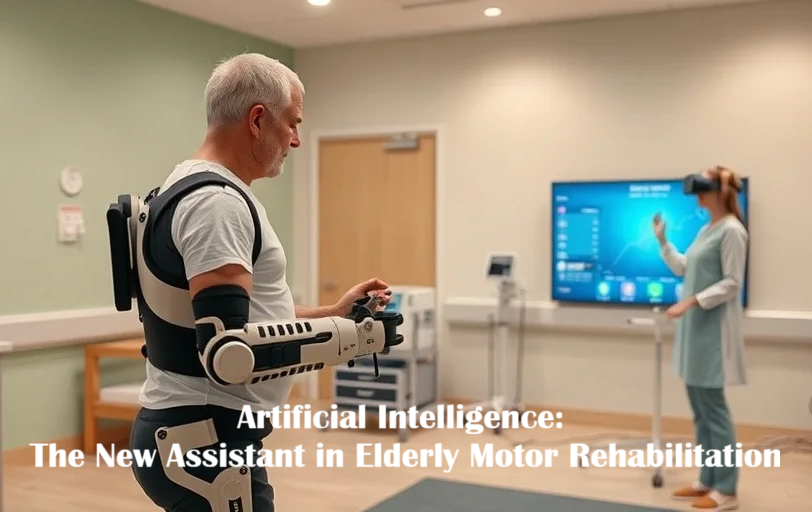هوش مصنوعی؛ دستیار نوین در توانبخشی حرکتی سالمندان

فناوری، مرزهای درمان را پشتسر گذاشته و اکنون با کمک هوش مصنوعی، گام به گام کنار سالمندان ایستاده تا استقلال حرکتیشان را بازگرداند.
نویسنده: دکتر نسیم فروغی | دکترای بایومکانیک بالینی – دانشگاه سیدنی
رادیونشاط- در دنیای امروز، فناوری نهتنها مرزهای درمان را جابهجا کرده، بلکه بهطور مستقیم به یاری انسان برای بازگشت به استقلال جسمی آمده است. یکی از شاخههایی که تحول چشمگیری در سالهای اخیر تجربه کرده، استفاده از هوش مصنوعی در توانبخشی حرکتی سالمندان است؛ حوزهای که میان علم بایومکانیک و یادگیری ماشین پیوندی بیسابقه ایجاد کرده است.
به عنوان پژوهشگر بایومکانیک بالینی، باور دارم که هر حرکت انسانی، مجموعهای از دادههای پیچیده است. راهرفتن، برخاستن از صندلی یا حتی تعادل در ایستادن، حاصل هماهنگی صدها عضله و مفصل است. اکنون، با کمک الگوریتمهای یادگیری ماشین، میتوان این دادههای حرکتی را تحلیل کرد و از میان میلیونها الگو، نشانههای اولیهی ضعف عضلانی یا خطر سقوط را پیش از بروز آسیب شناسایی نمود.
در دانشگاه سیدنی، پروژههایی در حال اجراست که از حسگرهای پوشیدنی هوشمند و مدلهای یادگیری عمیق (Deep Learning) برای ثبت و تحلیل حرکت سالمندان استفاده میکنند. این سیستمها با ثبت جزئیترین نوسانات حرکتی – از سرعت قدمها تا زاویهی چرخش لگن – میتوانند الگوهای ناهنجار را شناسایی کرده و به درمانگران هشدار دهند. بهاینترتیب، برنامههای تمرینی دقیقتری برای هر فرد طراحی میشود که با وضعیت خاص بدن او سازگار است.
کاربرد دیگر هوش مصنوعی در توانبخشی، در طراحی رباتهای کمکی و اسکلتهای بیرونی (Exoskeletons) است؛ ابزارهایی که با تحلیل لحظهبهلحظهی وضعیت بدن، میزان حمایت مکانیکی را بهصورت خودکار تنظیم میکنند. نتیجه، حرکتی طبیعیتر، ایمنتر و با مصرف انرژی کمتر برای سالمند است.
از منظر بالینی، آنچه بیش از همه اهمیت دارد، شخصیسازی درمان است. فناوری یادگیری ماشین این امکان را فراهم کرده تا بهجای نسخههای عمومی تمرینات فیزیکی، برنامههایی کاملاً فردی تدوین شود. برای مثال، اگر الگوریتم دریابد که عضلات ساق پای بیمار در فاز میانی راهرفتن ضعف دارد، تنها همان بخش هدف تمرین قرار میگیرد.
اما نقش فناوری در اینجا پایان نمییابد. دادههای جمعآوریشده از هزاران فرد سالمند، به دانشمندان اجازه میدهد تا الگوهای جهانیترِ پیری حرکتی را بشناسند و مدلهای پیشبینی توسعه دهند. این مدلها میتوانند سن بیومکانیکی بدن را برآورد کرده و حتی خطر افتادن یا آسیب در آینده را پیشبینی کنند.
با وجود پیشرفتهای چشمگیر، چالشهایی نیز وجود دارد؛ از جمله حفظ حریم خصوصی دادههای حرکتی، هزینهی بالای تجهیزات هوشمند و نیاز به آموزش درمانگران برای کار با فناوریهای جدید. با این حال، آیندهی توانبخشی بهروشنی در مسیر دیجیتالی شدن پیش میرود.
در نهایت، باور دارم که هوش مصنوعی نه جایگزین انسان، بلکه همراه او در مسیر استقلال است. هدف نهایی از این پژوهشها، نه فقط تحلیل حرکت، بلکه بازگرداندن امید، اطمینان و کیفیت زندگی به سالخوردگانی است که هنوز میخواهند زندگی را با گامهایی استوار تجربه کنند.
-----------------------
Artificial Intelligence: The New Assistant in Elderly Motor Rehabilitation
Technology has pushed the boundaries of medicine and now, with the help of artificial intelligence, stands step by step beside the elderly to restore their physical independence.
Author: Dr. Nasim Foroughi | PhD in Clinical Biomechanics – University of Sydney
Radio Neshat – In today’s world, technology has not only redefined the limits of medical treatment but has also directly aided humans in regaining physical independence. One of the fields that has undergone remarkable transformation in recent years is the use of artificial intelligence in elderly motor rehabilitation — an area that has forged an unprecedented link between biomechanics and machine learning.
As a researcher in clinical biomechanics, I believe every human movement represents a complex dataset. Walking, standing up from a chair, or even maintaining balance involves the coordination of hundreds of muscles and joints. Now, with the help of machine learning algorithms, these movement data can be analyzed to identify early signs of muscle weakness or risk of falling — long before an injury occurs.
At the University of Sydney, several ongoing projects employ smart wearable sensors and deep learning models to record and analyze the movement of elderly individuals. By capturing the slightest motion variations — from step speed to hip rotation angles — these systems can detect abnormal patterns and alert therapists. This enables the creation of highly tailored exercise programs suited to each person’s physical condition.
Another important application of AI in rehabilitation is in the design of assistive robots and exoskeletons. These devices continuously analyze body posture and movement, automatically adjusting the level of mechanical support. The result is smoother, safer, and more energy-efficient motion for elderly users.
From a clinical perspective, personalization of therapy is the key. Machine learning technology allows us to move beyond general exercise prescriptions and develop individualized rehabilitation plans. For example, if an algorithm detects weakness in the calf muscles during mid-gait, it can target that specific phase for improvement.
The role of technology, however, extends even further. Data collected from thousands of elderly participants help scientists identify global movement aging patterns and develop predictive models. These models can estimate the biomechanical age of the body and even forecast the likelihood of future falls or injuries.
Despite these advances, several challenges remain — including data privacy concerns, the high cost of smart devices, and the need for specialized training for therapists. Nonetheless, the future of rehabilitation is clearly moving toward a fully digital path.
Ultimately, I believe that artificial intelligence is not a replacement for humans but a companion on the journey toward independence. The true goal of this research is not merely to analyze motion, but to restore hope, confidence, and quality of life to older adults who still wish to experience life with steady, confident steps.

